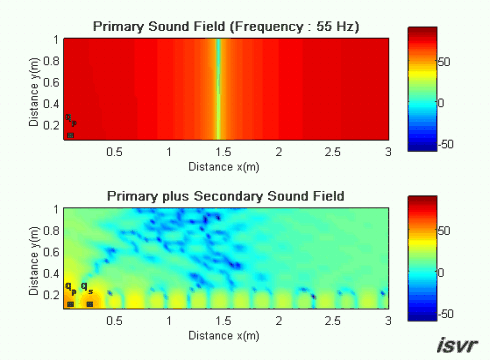ACTIVE NOISE CONTROL
The ISVR has been
involved in active control research for many years. Early work was
carried out on active headsets, and further studies were undertaken on the active control of
enclosed soundfields.
Why Active Noise
Control ?
There are several ways to
reduce the noise levels emitted by a sound source in a room. One standard
approach consists of passive noise absorption, i.e. covering the
walls with absorbing materials like glassfibre coatings. These materials
dissipate acoustic energy into heat and so contribute to the noise
reduction, but they work best at high frequencies (e.g. above 500 Hz). Active Noise Control
systems have been developed to overcome the limitations of passive
strategies at low-frequencies (e.g. below 100 Hz).
How does it work ?
Active noise control
tries to eliminate sound components by adding the exact opposite
sound. As we saw earlier when we studied superposition of waves, two
waves with equal amplitude and identical phase add together
constructively, resulting in a doubling of overall amplitude. On the
other hand, two waves with equal amplitude and opposite phase add
together destructively, resulting in a cancelling of overall
amplitude. The phase describes the relative position of the wave in its
rising and falling cycle. If two waves are in phase, they rise and fall
together, whilst if they are exactly out of phase, one is rises as the
other falls, and so they cancel out.
By detecting unwanted sounds with
microphones the active noise control system can automatically generate the
correct signal to send to loudspeakers which will produce anti-sound
to cancel out the original sound. The size of the zone of silence
created depends on the wavelength of the sound. The effectiveness of
the system will depend on the size and shape of the room in which it is
applied, the size of the unwanted source of sound and the number and
positions of loudspeakers used to generate the anti-sound.
• Active noise
control in a room with swept frequency
The animations below show
how the acoustic pressure distribution generated by one primary
loudspeaker located at the lower left corner of the room (mid figure,
primary field) is modified by a secondary loudspeaker, or 'anti-sound'
source, located next to it and suitably driven in order to achieve attenuation of sound
throughout the entire enclosure (bottom figure, primary and secondary
field). This represents the best possible situation for the application of
active noise control, where the primary source is small and the secondary
source can be placed close to it. The animations illustrate how the resonance patterns (due to
standing waves in the room) are changed as frequency increases. You can
see how the resonance mode shapes in the room are 'redistributed'
when the active noise control system is turned on.


Research into the active
control of enclosed sound fields has produced practical demonstrations of
control inside cars (1986), aircraft (1988) and helicopters (1995).
Further illustrations are shown in section 2.